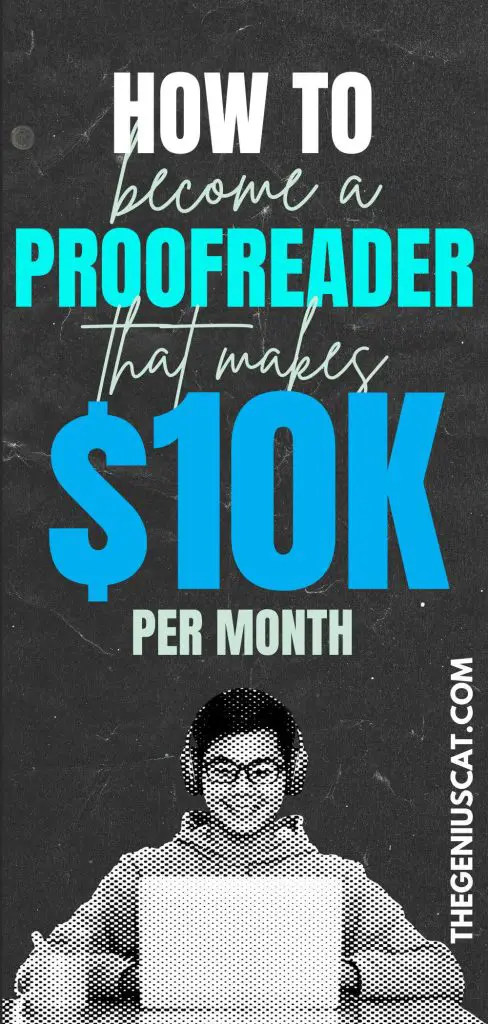Heads Up: For the sake of transparency, this post might contain affiliate links. If a sale is made, I will receive a small commission (at no additional charge for you), which helps keep the lights on and helps feed my cats. Please read our disclosure policy for more information.
You know that little twitch in your eye when you see “your” instead of “you’re”? Yeah, me too.
What if you could turn that keen eye for detail into a real paycheck? That’s exactly what learning how to become a proofreader can do for you.
If you love reading, fixing errors, and polishing sentences until they shine, proofreading might just be your perfect side hustle or even a full-time gig.
Imagine getting paid to do what you naturally enjoy, all while working from your couch in pajamas (no judgment here).
In this post, I’ll walk you through what a proofreader actually does, how much you can realistically earn, and why this could be one of the most flexible ways to make money online.
By the time you’re done reading, you’ll have a clear idea of whether this path is right for you and how to take the first step.
- Why Proofreading Could Be Your Next Big Move
- How to Become a Proofreader From Home
- Step 1: Assess Your Proofreading Skills
- Step 2: Understand What Proofreading Really Involves
- Step 3: Invest in the Right Training (Skip the Guesswork)
- Proofread Anywhere
- Step 4: Build Your Proofreading Toolkit
- Step 5: Choose Your Niche (Where the Money Is)
- Step 6: Set Up Your Proofreading Business
- Step 7: Find Your First Clients
- Step 8: Scale Your Proofreading Side Hustle
- Tip 1: Time Management
- Tip 2: Handling Challenges and Difficult Clients
- Tip 3: Creating Work-Life Balance
- Tip 4: Common Mistakes to Avoid
- Conclusion – Final Push to Get You Started
- Liked This Post?
Ready to turn your grammar skills into income? Save this guide on how to become a proofreader and pin it to your Pinterest board so you can start your journey anytime!

Why Proofreading Could Be Your Next Big Move
- You already have the skills – If spotting typos in menus or cringing at misplaced apostrophes is your thing, you’re halfway there.
- Work from anywhere – All you need is a laptop, an internet connection, and maybe a cozy coffee shop corner.
- Set your own hours – Early bird or night owl? You decide when you work.
- Solid earning potential – Freelance proofreaders can charge anywhere from $20 to $50 per hour, and experienced ones make even more.
(P.S. If you’re ready to jump in, I put together a list of the 21 best online proofreading jobs for beginners to help you land your first gig fast.)
Proofread Anywhere
In this free workshop, you’ll learn how to become a proofreader and start a freelance proofreading business.
- 24,000+ Students
- 7+ Years of Results
Related Posts You Might Be Interested In:
- 21 Best Online Proofreading Jobs For Beginners (Earn $45/hour)
- 7 Reasons Why Proofreading Is the Best Job for Introverts
How to Become a Proofreader From Home
This isn’t just some side hustle. For some people, it’s a full-blown career that lets them work from anywhere. Bali? Sure. Tiny cabin in the woods? Why not.
So… Ready to see how it works? Keep reading, and I’ll break it all down for you.
Step 1: Assess Your Proofreading Skills
You’re probably already proofreading without realizing it. Every time you cringe at a misplaced apostrophe on a restaurant menu or spot a “there/their/they’re” mix-up in a Facebook post, you’re flexing those proofreading muscles.
The question is: are you actually good enough to get paid for it? Here’s how to find out:
First, try this: open any book or website and read a random paragraph. How many errors did you catch? If you’re spotting at least 3-4 things you’d change, that’s a solid start.
Next, take some free online tests (Grammarly’s quiz is surprisingly brutal in the best way). These will show you where you really stand – no sugarcoating.
The best proofreaders I know share three traits:
- They’re borderline obsessive about details (you know who you are)
- They actually enjoy the process of making their writing cleaner
- They have the patience to scan the same sentence five times
You don’t need to be perfect right now. But if you’ve got that itch to fix errors and can stay focused, you’re already ahead of 90% of people who “think” they can proofread.
Pro tip: Keep a notebook of common mistakes you spot in everyday life. It’ll sharpen your eye faster than you’d think.
Step 2: Understand What Proofreading Really Involves
Most people think proofreading just means “checking for mistakes.” But here’s where they get it wrong.
Proofreading is actually the final polish before something gets published, while editing involves rewriting awkward sentences, and copyediting focuses on style and flow.
You could be working on anything from indie romance novels (yes, those steamy ones count) to corporate annual reports.
Blogs need proofreaders. Resumes need proofreaders. Even those annoying Facebook ads you scroll past? Someone gets paid to fix those commas.
Your daily grind would look like:
- Hunting down sneaky typos that somehow survived three drafts
- Making sure every Oxford comma is in its rightful place
- Checking if headings are consistently bolded (because nothing hurts more than random formatting)
It’s not glamorous work, but when you see that final clean version? Pure satisfaction. The key is knowing exactly what level of changes you should (and shouldn’t) make as a proofreader versus an editor.
Quick test: If you read this paragraph and mentally correct something, you’re already thinking like a proofreader.
Step 3: Invest in the Right Training (Skip the Guesswork)
Winging it as a beginner proofreader might sound like a good idea, but it usually leads to confusion, wasted time, and missed opportunities. Without clear guidance, it’s easy to second-guess every decision and stall progress before ever landing a client.
While you can absolutely learn through free resources, what’s often missing is a clear, step-by-step path that turns proofreading into a real income source. Random blog posts won’t walk you through handling messy manuscripts or navigating tricky client situations.
That’s why many aspiring proofreaders turn to Proofread Anywhere by Caitlin Pyle (this is an affiliate link). It stands out for a few solid reasons:
- They don’t just teach proofreading – they show you how to run a freelance business
- You get actual practice with real-world documents (none of that textbook-perfect copy nonsense)
- The certification is recognized and respected by clients
The course also throws in:
- Ready-to-use scripts for reaching out to potential clients (no awkward “um, I’m new” conversations)
- How to pick a profitable niche (academic vs. fiction pays very differently)
- Contract and invoice templates to help you look professional from day one
Yes, there are free alternatives out there. But they’ll leave you stuck on the basics while paid students are already booking clients. Think of it this way: that course fee could be one client project’s earnings later.
Side note: If your budget’s tight, at least grab their free workshop first. It gives a solid taste of what the full course offers.
Proofread Anywhere
In this free workshop, you’ll learn how to become a proofreader and start a freelance proofreading business.
- 24,000+ Students
- 7+ Years of Results
Step 4: Build Your Proofreading Toolkit
You wouldn’t show up to a construction site without tools, right? The same goes for proofreading. Here’s what you actually need in your digital toolbox:
First, Grammarly. The free version catches basic errors, but the premium is worth it for serious work (that tone detector saves lives). Just remember – it suggests, you decide.
Style guides are essential, too. Chicago Manual for books, AP Style for journalism. Pick one based on your niche and keep it bookmarked.
Hemingway Editor keeps writing clear and punchy. Paste in text, and it highlights dense sentences like a strict English teacher.
And to keep things organized:
- Trello boards to track client projects
- Google Docs for live editing (never lose work again)
- A simple spreadsheet for income tracking
Pro tip: Create a style sheet template for recurring clients. It saves hours by recording their preferences for things like Oxford commas or heading formats.
Step 5: Choose Your Niche (Where the Money Is)
Not all proofreading work pays equally. Specializing allows you to charge premium rates because you’re not just correcting grammar – you’re speaking the client’s language.
The most lucrative niches tend to be:
Academic Proofreading
Researchers and students need their papers polished to perfection. This requires knowledge of specific citation styles but commands higher fees.
Self-Publishing Authors
The indie book market is booming. Authors on platforms like Amazon Kindle need affordable proofreading services and often provide repeat business.
Business & Marketing Materials
From website copy to executive resumes, businesses pay well for error-free content that represents their brand professionally.
Specialization works because:
- You develop expertise that clients are willing to pay extra for
- Marketing becomes easier when you target a specific audience
- You work more efficiently within familiar formats
The key is picking a niche that aligns with both market demand and personal interest. A medical proofreader, for example, can charge more but needs relevant knowledge. Start broad, then narrow down as you discover what work you enjoy most.
Step 6: Set Up Your Proofreading Business
Before taking clients, get your business foundation right. First, decide on your structure. Most starters begin as sole proprietors before considering an LLC for liability protection. Tools like FreshBooks or Wave simplify invoicing and tax tracking, saving headaches come tax season.
Every serious proofreader needs an online home. Instead of just a basic portfolio site, consider starting a blog. It serves multiple purposes: showcasing your skills through sample edits, demonstrating expertise with grammar tips, and attracting clients organically. A blog builds credibility that static websites can’t match.
For those unsure where to begin, I offer a free 7-day email course on starting a blog the right way – no technical experience needed. It walks through choosing platforms, designing for maximum impact, and creating content that converts visitors into clients.
Pricing should reflect your level:
- Beginners: $20-$30/hour
- Intermediate: $30-$40/hour
- Specialists: $40+/hour
Your website and blog work around the clock, even when you’re not. A solid online presence makes it easier for clients to find you and feel confident paying higher rates. Start simple, but set it up the right way from the beginning. It really pays off.
Step 7: Find Your First Clients
Landing those initial proofreading gigs can feel impossible, especially when you’re not sure where to even start. But there are actually more opportunities out there than most beginners realize.
Start with free methods that don’t require any prior experience:
- Cold emailing local businesses and bloggers – many don’t realize they need proofreading help until someone points out errors
- Facebook groups like Authors & Editors regularly have authors seeking affordable proofreaders
- Create a niche-focused Upwork profile. Highlight specific skills, like academic papers or romance novels. That kind of detail helps you stand out.
For those willing to invest time, my post on the best online proofreading jobs for beginners lists 21 places to find work immediately, including platforms you might not have considered.
If you want to skip the hustle, paid job boards like ProofreadingPal and FlexJobs offer pre-vetted opportunities. While some require tests or samples, they often lead to steady work faster than cold pitching.
The secret isn’t finding more clients – it’s finding the right clients who value your specific skills. Start small, collect testimonials, and watch your client list grow organically.
Step 8: Scale Your Proofreading Side Hustle
Once you’ve got steady clients coming in, it’s time to turn your side hustle into something bigger. The first golden rule? Never let a happy client leave without asking for a testimonial. Those few sentences of praise become marketing gold when landing new projects.
Smart proofreaders know their worth increases with experience. After completing 10-15 quality jobs, bump your rates by 10-20%. Regular clients will understand, and new ones will assume you’re worth it.
When you start turning work away because you’re booked solid, that’s your cue to bring in help. Train a virtual assistant to handle basic proofreading tasks or administrative work. This lets you focus on higher-paying projects while still taking on more volume.
The most successful proofreaders don’t just work harder – they work smarter. Systemize your processes, create templates for common edits, and consider offering premium packages. Before you know it, what started as extra income could replace your day job entirely.
There you have it…
Everything you need to launch your proofreading career from home. Before we wrap up, here are four golden nuggets that’ll save you headaches and boost your success:
Tip 1: Time Management
Working from home sounds dreamy until Netflix beckons. Block specific hours for client work (morning person? Capitalize on that). Use tools like Toggl to track time and schedule buffer periods between projects. Pro move: Dedicate one day weekly to admin tasks so they don’t hijack your workflow.
Tip 2: Handling Challenges and Difficult Clients
Some clients will insist “their version” is correct (it’s not). Stay professional but set boundaries early. Use contracts outlining revision limits, and don’t be afraid to fire clients who disrespect your time. A polite “I’m not the right fit” saves sanity.
Tip 3: Creating Work-Life Balance
Set physical boundaries (no laptops in bed!) and mental ones too. Turn off notifications after 6 PM, and take real weekends. Burnout helps no one, least of all your bank account.
Tip 4: Common Mistakes to Avoid
Underselling yourself tops the list. Charging $10/hour attracts nightmare clients. Also, skipping contracts or overpromising turnarounds leads to disaster. Track every edit – clients will question changes.
Conclusion – Final Push to Get You Started
Okay, you could keep researching and doubting yourself forever. Or you could start getting paid for skills you already have. Which sounds better?
Good proofreaders aren’t born perfect. They become great by doing the work. Every expert was once a beginner who decided to try.
Three things that separate successful proofreaders from dreamers:
- They start before feeling ready
- They connect with others doing the same work
- They never stop improving their craft
The tools are all here. The need for proofreaders isn’t going away. The only thing missing is your decision to begin.
So what’s really holding you back? That voice saying “I’m not good enough”? Every professional has heard that same voice and kept working anyway.
You notice errors others miss. That’s not a quirk. It’s a valuable skill people will pay for. The first step is simply deciding to treat it that way.
The clients are out there. The work exists. Your opportunity starts when you do.
Ready to begin properly? Proofread Anywhere gives you the clear path forward. Or go it alone. But start today either way.
Your future self will thank you for beginning now rather than “someday.” That someday could be today. What’s stopping you?
Proofread Anywhere
In this free workshop, you’ll learn how to become a proofreader and start a freelance proofreading business.
- 24,000+ Students
- 7+ Years of Results
Liked This Post?
If this guide on how to become a proofreader got you excited (or finally convinced you this is possible), pay it forward! Tap one of the share buttons below to help others discover this opportunity. Want to save these steps for later? Pin the image below to your favorite Pinterest board. For more introvert-friendly ways to make money from home, be sure to follow me on Pinterest.



